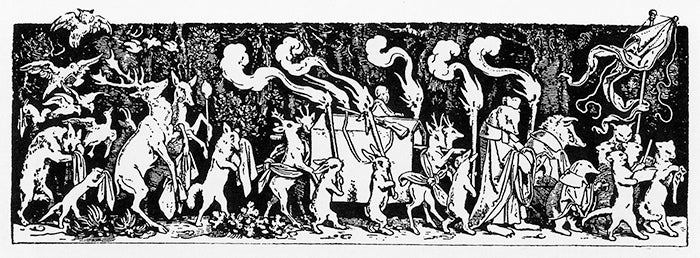Mahler’s Musical Parody
Mahler’s First Symphony takes the listener on a musical journey through varying themes. It opens with a clear landscape as an offstage trumpet calls and suspended sounds make up the initial statements. Moving forward, the symphony unfolds in drama and elation—describing heartache and the joys of nature. In the second movement, especially, he seems to honor his heritage with a minuet-and-trio-inspired dance style.
The third movement is where the piece takes a bizarre turn. It starts with a funeral procession. The tune of the procession is, somewhat randomly, a children’s nursery rhyme—what we know today as “Frère Jacques.” However, Mahler scores it in a minor key, creating a sad, dark mood. Possibly the most odd decision of this opening is giving the initial statement to a solo bass.
The sound is boorish, especially on an instrument of the late 1800s. This decision is almost certainly an ironic one. Supporting this idea is the painting that first inspired this movement—Moritz Von Schwind’s The Hunter’s Funeral.

At the center of this artwork, Schwind places the pyre of a deceased hunter. The surrounding procession is made up entirely of animals, specifically animals that are popular hunting targets. The depiction is entirely ironic, as the obvious reaction of animals to a dead hunter should be celebration, not grieving.
Then, if the “funeral procession” didn’t seem out-of-place enough, Mahler slowly moves towards a Jewish music style, mimicking the Klezmer band of his heritage. He uses over-exaggerated orchestrations, further developing the newfound ironies and contradictions that are now a part of the symphony.
What’s going on here? A symphony that began with the music of nature, love and innocent folk dances in the first two movements, is all of a sudden an amalgamation of histrionics?!
By the age of 28, Mahler had discovered the practice of the musical “joke” (more specifically, sarcasm) that Beethoven outlined throughout his career, and for which Shostakovich would eventually become well-known. More importantly, Mahler made it his own, molding these practices to fit his own personal drama and his own voice.
This spiral of stark juxtapositions is what would eventually mark Mahler the innovative composer we know and love. This conflicted man and his music would speak to the post-WWI & WWII audience of the late 20th and early 21st century very deeply. It is no wonder why Mahler’s symphonies are sometimes considered “prophetic,” as they not only sympathize with the world before and around him, but especially with the post-modern world of today.
Hear Mahler’s First Symphony alongside Brahms’ Violin Concerto and Bernstein’s Overture to Candide on the NJSO’s season-finale program June 7–10.